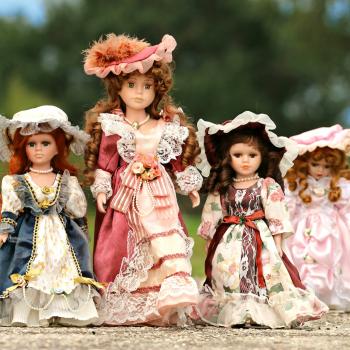By Samantha
Originally posted on Defeating the Dragons
I was in a conversation a few days ago that has stayed with me, and I think what I noticed is important. A few moms brought up how their children respond to church services, and as a part of that discussion, one mother mentioned that her son said “the music gave him a stomach ache.” Responses were along the lines of “well, no wonder, rock concerts in church aren’t very restful.” It seemed to me that they were chalking up this toddler’s “stomach ache” to a general distaste with evangelical worship services, but when I heard the phrase stomach ache, instant red flags went up for me.
As I shared with you a little while ago, I’ve had problems with anxiety for most of my life, starting from when I was fairly young. I didn’t know the word anxiety described what I felt; what I did know was that “worry” and “anxiety”– anything less than “rejoicing in the Lord always,” really– was a sin. Anyway, when I heard that this child used the word “stomach ache” to try to explain how he felt, I instantly connected with it: my anxiety usually starts with shaky, nervous flutterings before escalating into full-blown clammy skin, heart palpitations, and, lastly, nausea. I didn’t know how to communicate “heart palpitations” to my parents, though, so I almost always settled on “stomach ache” when I’d experienced a trigger for too long and ended up nauseated.
One of the things guaranteed to set off an episode? Live drums and heavy bass. Which are heavily featured in modern church worship services. I have always skipped the music portion for this reason. But, it took me twenty-five years to understand that the reason why I avoid loud rock/pop music like the plague is my anxiety. I knew a lot of different people didn’t enjoy concert-style worship, and I was happy my partner was willing to arrive late every Sunday because of that, but what I didn’t know is that “concert style music makes me feel like my rib cage is about to burst open and my heart explode” isn’t normal. Most people don’t want to lay down on the floor and cradle their head, or fantasize about shoving their head into a bucket of ice.
I suggested to the mom that it might be a good idea to ask her son other questions geared toward figuring out if he was experiencing other anxiety-related symptoms– like “does your chest hurt?” or “do you feel hot or cold?” or “does your neck hurt?”
What has stuck with me about this particular conversation is the reaction I got: it had never occurred to these moms to wonder if their kids might be struggling with anxiety– social anxiety or otherwise. These moms are wonderful, loving people. They adore their kids. They’re responsible parents.
And yet, “maybe he doesn’t like XYZ because he has anxiety” just wasn’t an option they’d considered.
This isn’t their fault. It’s our culture’s fault. A culture with two glaring problems:
1) Mental illness is stigmatized, ignored, reviled– and so are the people who have it.
2) Children are expected to be in the default state of “cheerful” at all times.
A little while ago I was able to meet up with one of my favorite bloggers, Libby Anne from Love Joy Feminism. She brought Sally and Bobby with her, and something that happened that day is seared into my brain. We were in a museum, and it was loud, and crowded, with people bumping into each other all day. Several of the exhibits were filled to the brim with bright colors, flashing lights, and a screen with a different video every few yards. To say that it was a “stimulating environment” would be an understatement.
At one point, Sally (who was five years old at the time) was starting to spin up– anyone could recognize that she was heading toward a meltdown. But, suddenly, the most amazing thing happened. Sally turned to her mother and said “I need to go sit down.” And she did. She found an alcove– one of those darkened rooms that play short documentaries– and sat down on one of the benches and put her head in her lap. I studied her, and she was obviously focusing on breathing slowly, on calming herself down.
I was … amazed. A five year old had figured out something about herself that I still struggle with. She realized that she’d become overstimulated, was getting tired and stressed, and she knew what to do to handle it. She knew it was the noise, the people, the press, the displays, and so she found an environment with the least amount of stimulation possible– somewhere dark and quiet. I stared at her with my mouth open, and turned toward Libby Anne and whispered “how in the world did you teach her that? I don’t know how to do this!”
~~~~~~~~~~
One of the things I’ve learned from Libby Anne is the radical notion that children are people. I wish that wasn’t such a startling statement, but for our culture, it very much is. Our culture doesn’t recognize the full humanity of our children. In fact, in order to be a good, responsible parent, many people think success comes when children are utterly controlled. Every single second of their lives is managed by us– including their emotional lives. Meltdowns, crankiness, sadness, melancholy, moodiness, anger, frustration, irritability– these things are strictly not allowed in “well-behaved” children. Only spoiled little brats have “negative” emotions.
Except we don’t think the same thing of adults. Granted, none of us enjoys it when our friends or co-workers are cranky, or irritated, or frustrated, but we make allowances for it because we understand what it’s like to “wake up on the wrong side of the bed.” However, children don’t get to be grumpy because things in their day have just been going wrong– not well-behaved children, at least.
This is exacerbated in Christian culture. While we might think “children are to be seen and not heard” is an archaic phrase, Christians still tend to operate by that,especially when it comes to the emotional spectrum. Children are to be joyful. Children are to be peaceful. Children are to be pleasant. Children are to be polite. When they are anything less than that, it’s a sign of a problem that needs to be corrected through whatever discipline method that parent subscribes to.
A “shy” child– who might actually struggle with social anxiety or are extremely introverted and have used up all their energy already? NOPE. NOT ALLOWED. We coax, we cajole– we might even command our children to ignore their own emotional health because we want to introduce them to someone they’ll never speak to again. A child that hates highly stimulating environments? Too bad. They are going into that Sunday school room with bright primary-color murals on every single wall and the teacher who shout-talks the entire time and they had better not be a “problem.” Could they have anxiety, or be highly sensitive? We’re not even going to ask that question.
We are given tons of education and information about a host of other things– we all know to look for signs of lice, or chicken pox. We know what to do to treat a cold, we understand the difference between the common head cold and what could be the flu.
But how many of us know what the symptoms of anxiety or depression are? The realones, not the ones we see in movies? I believe that being able to recognize when our children might be struggling with anxiety or depression is just as necessary as knowing when they have the chicken pox. If we don’t see it– if all we see is a “spoiled brat” or a “problem child,” then we’ll never be able to get them treatment. I grew up not knowing how to manage my anxiety, so I’m having to learn all the tools and coping mechanisms now, as an adult. I have trouble recognizing when I’m about to over-stress myself, because that threshold is so invisible to me.
It doesn’t have to be this way. I believe it shouldn’t be this way.













